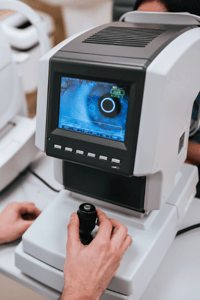5 Easy Ophthalmology Billing Tips to Get Paid Faster
Posted by Janna Vienca Cañezal
Practice Management Ophthalmology Medical Billing
Getting paid is a top priority for any business, and your ophthalmology practice is no different. However, ophthalmology billing presents many challenges that most other specialties don’t have to take into account.
What Makes Ophthalmology Billing Different?
From dividing funds between the facility, the provider, and anesthesia, to co-management and handling two sets of diagnosis codes, there’s plenty that can cause confusion and lead to rejection if mishandled.
Whether you have an in-house biller or outsource your billing services, the billing process’s initial step will depend on the healthcare provider. Making sure your team is comfortable with the steps is essential. Here are some ophthalmology billing tips you can use to get paid faster, minimize rejections, and create an overall efficient billing system.
1. Know Your Payers
Medicare and commercial insurance companies have different ophthalmology billing guidelines. Even within Medicare, individual MACs have varying requirements, including how to code a bill and the documentation needed.

For example, Medicare requires providers to bill bilateral claims by listing the procedure code on the claim with the modifier 50. On the other hand, commercial payers want you to record the procedure code on one line with the modifier LT and then the modifier RT on the following line.
To help you get paid on the first submission, you must know and follow each payer’s guidelines. Always check payer rules, exam elements performed, and medical necessity requirements. If you are billing for Medicare, subscribe to CMS email updates to receive notification regarding coverage updates.
One best practice is to create a payer matrix with your most commonly billed codes and how they differ between payers.
2. Correctly Choose Between Eye Codes and E&M Codes
The ability to differentiate using one type of code over another is an essential skill for ophthalmologists. Both codes share the same general principles, but they have a couple of elements that set them apart. All payers standardize the documentation required for E&M codes, but documentation for eye codes vary by state and payer.
There are no frequency edits for E&M codes. However, specific eye codes like 92014 are limited for billing once in 12 months. It is best to check your patient’s history first before using this code.
Watch: Get Paid What You Deserve — Navigating 2021’s E&M Coding Changes
E&M codes often apply to more severe conditions and systemic diseases, but eye codes can apply to a variety of medical situations and vary from payer to payer.
Furthermore, E&M codes are typically used for medical exams, while eye codes are used in vision exams, depending on payer rules.
So how exactly do you decide which code to use? The American Academy of Ophthalmology published a comprehensive guide for ophthalmology billing outlining when to bill for eye or E&M codes.
3. Make Your Patient Statements Clear and Easy to Read

This is an excellent fundamental to keep in mind, whether billing for ophthalmology or any other specialty. Medical billing statements are often confusing, especially when packed with medical codes and jargon. Far too often, that leads to patients procrastinating and pushing the statement off, delaying and lowering your chances of getting paid.
Explain the services in simple words. Avoid using medical terms and jargon that they might not understand. Instead, give a description of the services or procedures performed and what is due from their end.
Use a clean layout with lots of white space. White space improves a reader’s comprehension and lets your patients focus on the critical text. It may not seem like much, but a thing as simple as an easy-to-read billing statement can increase patient satisfaction.
4. Be Careful with Out-of-Network Billing
You might resort to out-of-network (OON) billing at some point because of a potential increase in revenue. However, it is vital to note that this will open you to some risks like late payments, increased denials, and worse.
If you decide to bill out of network, be transparent with your patients and provide an estimate of expected costs upfront to avoid difficulties in collecting payments later on. If you aren’t transparent about being OON and the high cost it will entail, it can cause financial distress to your patients. Additionally, surprise billing can get the attention of state and federal lawmakers.
Avoid waiving co-pays or out-of-pocket payments constantly because it can implicate the Anti-Kickback Statute.
5. Know When to Bill a Patient’s Vision or Medical Insurance
Since patients have both medical and vision insurance, it can be confusing to select which one to bill, especially when patients ask you to charge one instead of the other.

Vision insurance is for “routine” eye examinations, and insurances usually allow one routine examination per calendar year. On the other hand, medical insurance applies when there is a medical symptom or ongoing care for a medical condition.
Many eye exams could fall under both vision and medical insurance, but the chief complaint and diagnosis are typically what most insurance companies look into. For example, say a patient comes in with red-eye. Since red-eye is a sign of an underlying medical condition, you would bill the visit under medical insurance and not vision insurance.
For proper guidance, it is always best to check with your payers as to their policy for eye exams. Additionally, always check your patient’s eligibility for both medical and vision plans before the office visit.
Using Your EHR to Streamline Your Ophthalmology Billing Workflow
EHR-integrated billing software can make all the difference in your billing workflow and, ultimately, improve your bottom line. That is especially true if the system includes optimization for the intricacies of ophthalmology billing.
Meditab’s own software, IMS, is a platform designed with precisely that kind of workflow improvement in mind. An all-in-one EHR, practice management, billing, and office management system, IMS and the other EHRs like it feature tools meant to work with the specifics of ophthalmology.
Taking a fully digital surgery planning sheet, for instance, and connecting it seamlessly with your eventual superbill means fewer steps for every member of your team. In the case of IMS, where this functionality is combined with in-house billing systems like daily eligibility checks and clearinghouse integration, it means your bills are faster and more accurate.
Meditab and IMS Are Helping Practices
Throughout the Industry Recover and Grow
Share this post: on Twitter on Facebook on Google+


